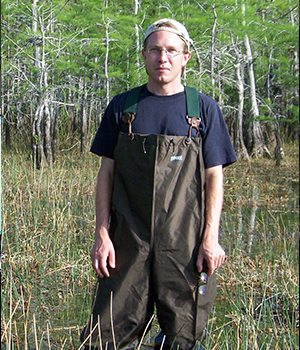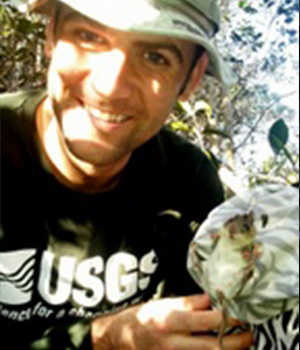

All populations fluctuate over time. How much of this variation is due to random events, and how much can we predict from basic ecological theory? I am interested in how individual behavior and life history variation influence population dynamics, and how the feedback from population dynamics influences individual reproductive success. I use mathematical models to make predictions for a variety of taxa, in collaboration with field biologists working in marine, freshwater, and terrestrial habitats.


I use mathematical models to explore a wide variety of basic and applied issues in ecology. My research addresses questions across levels of organization from individuals to populations and communities.
Undergrad:
Disease Ecology and Ecoimmunology, BSC 4930.
Graduate:
Ecological Theory, PCB 6406.
PCB 6456 Experimental Design and Biometry.
Environmental Science Colloquium, EVS 6920 (required for Masters students in the Environmental Science Program)
Graduate Students
Jessene Aquino-Thomas, Integrative Biology PhD student
Hersh Chaitin, Integrative Biology PhD student
Julia Chapman, Environmental Science MS student
Krystyna Powell, Biology MS student
Alumni
Jason Bosley (co-supervised with J. Baldwin), PhD 2017
Stephen Ippolito (Math, co-supervised with V. Naudot), PhD 2015
James M. Beerens, PhD 2014
Jon Stonger, MS 2012
Adam Chen, BS 2012
Rachel Welicky (co-supervised with J. Wyneken), MS 2010
Simantha Ather, MS 2009
Shima, J.S., Noonburg, E.G., Swearer, S.E., Alonzo, S.H., Osenberg, C.W. 2018 Born at the right time? A conceptual framwork linking reproduction, development, and settlement in reef fish. Ecology, 99: 116-126.
Noonburg, E.G., Byers, J.E. 2016. Bad neighbors: how spatially disjunct habitat degradation can cause system-wide population collapse. Ecology, 97: 2858-2866.
Ippolito, S., Naudot, V., and Noonburg, E.G. 2016. Alternative stable states, coral reefs, and smooth dynamics with a kick. Bulletin of Mathematical Biology, 78: 413-435.
Beerens, J.M., Frederick, P.C., Noonburg, E.G., Gawlik, D.E. 2015. Determining habitat quality for species that demonstrate dynamic habitat selection.
Ecology and Evolution, 5(23): 5685-5697
.
Beerens, J.M., Noonburg, E.G., Gawlik, D.E. 2015. Linking dynamic habitat selection with wading bird foraging distributions across resource gradients.
PLoS ONE, 10(6):e0128182
.
Shima, J.S., Noonburg, E.G., Swearer, S.E. 2015. Consequences of variable larval dispersal pathways and resulting phenotypic mixtures to the dynamics of marine metapopulations. Biology Letters, 11: 20140778.
http://dx.doi.org/10.1098/rsbl.2014.0778
Noonburg, E.G., Chen, A., Shima, J.S., Swearer, S.E. 2015. Demographic heterogeneity and the dynamics of open populations. Ecology, 96: 1159-1165.
http://dx.doi.org/10.1890/14-1531.1
Naudot, V., Noonburg, E.G. 2013. Predator-prey systems with a general non-monotonic functional response. Physica D, 253: 1-11.
http://dx.doi.org/10.1016/j.physd.2013.01.019
Welicky, R., Wyneken, J., Noonburg, E.G. 2012. A retrospective analysis of sea turtle depredation patterns. Journal of Wildlife Management, 76: 278-284.
http://dx.doi.org/10.1002/jwmg.255
Noonburg, E.G., Nisbet, R.M., Klanjscek, T. 2010. Effects of life history variation on vertical transfer of toxicants in marine mammals. Journal of Theoretical Biology, 264: 479-489.
[
http://dx.doi.org/10.1016/j.jtbi.2010.02.017
]
Shima, J.S., Noonburg, E.G., Phillips, N.E. 2010. Life history and matrix heterogeneity interact to shape metapopulation connectivity in spatially structured environments. Ecology, 91: 1215-1224.
[pdf]
Byers, J.E., and Noonburg, E.G. 2007. Poaching, enforcement, and the efficacy of marine reserves. Ecological Applications 17:1851-1856.
[pdf]
Noonburg, E. G., Newman, L. A., Lewis, M. A., Crabtree, R. L., Potapov, A. B. 2007. Sequential decision-making in a variable environment: Modeling elk movement inYellowstone National Park as a dynamic game. Theoretical Population Biology 71:182-195.
[pdf]
Noonburg, E. G., and Byers, J. E. 2005. More harm than good: When invader vulnerability to predators enhances impact on native species. Ecology 86: 2555-2560.
[pdf]
Noonburg, E. G., and Abrams, P. A. 2005. Transient dynamics limit the effectiveness of keystone predation in bringing about coexistence. American Naturalist 165: 322-335.
[pdf]
Noonburg, E. G., and Nisbet, R. M. 2005. Behavioral and physiological responses to food availability and predation risk. Evolutionary Ecology Research 7: 89-104.
[pdf]
Noonburg, E. G., Shuter, B. J., and Abrams, P. A. 2003. Indirect effects of zebra mussels on the planktonic food web. Canadian Journal of Fisheries and Aquatic Sciences 60: 1353-1368.
[pdf]
Byers, J. E. and Noonburg, E. G. 2003. Scale dependent effects of biotic resistance to biological invasion. Ecology 84: 1428-1433.
[pdf]
Parker, H. H., Noonburg, E. G., and Nisbet, R. M. 2001. Models of alternative life history strategies, population structure and potential speciation in salmonid fish stocks. Journal of Animal Ecology 70: 260-272.
[pdf]
Noonburg, E. G., Nisbet, R. M., McCauley, E., Gurney, W. S. C., Murdoch, W. W., and de Roos, A. M. 1998. Experimental testing of dynamic energy budget models. Functional Ecology 12: 211-222.
[pdf]
Shea, K. and the NCEAS Working Group on Population Management. 1998. Management of populations in conservation, harvesting and control. Trends in Ecology and Evolution 13: 371-375.
Davis, A. W., Noonburg, E. G., and Wu, C.-I. 1994. Evidence for complex genic interactions between conspecific chromosomes underlying hybrid female sterility in the Drosophila simulans clade. Genetics 137: 191-199.
Johnson, N. A., Hollocher, H. H., Noonburg, E. G., and Wu, C.-I. 1993. The effects of interspecific Y-chromosome replacements on hybrid sterility in the Drosophila simulans clade. Genetics 135:443-453.
Erik G. Noonburg
Department of Biological Sciences at Florida Atlantic University
2912 College Ave. Davie, FL 33314
Education
1990-1994 University of Chicago. A.B. with honors in Biological Sciences.
1994-2000 University of California, Santa Barbara. Ph.D. in Biological Sciences.
Advisors: Roger M. Nisbet and William W. Murdoch. Dissertation title: Resource Allocation, Foraging Activity, and Life History Optimization in a Variable Environment.
Academic positions
2012-present Associate Professor, Department of Biological Sciences, Florida Atlantic University.
2006-2012 Assistant Professor, Department of Biological Sciences, Florida Atlantic University.
2005-2006 Research Associate, Department of Ecology, Evolution, and Marine Biology, UC Santa Barbara. Supervisor: R.M. Nisbet.
2003-2005 Postdoctoral Fellow, Centre for Mathematical Biology, University of Alberta. Supervisor: M. A. Lewis.
2000-2003 Postdoctoral Fellow, Dept. of Zoology, University of Toronto. Supervisors: P. A. Abrams & B. J. Shuter.